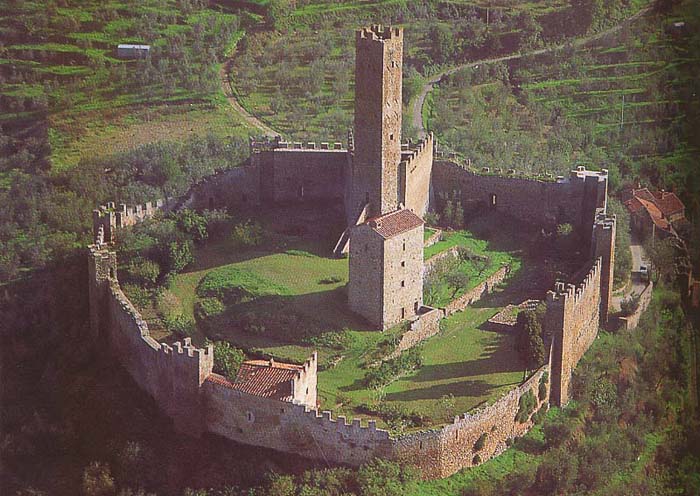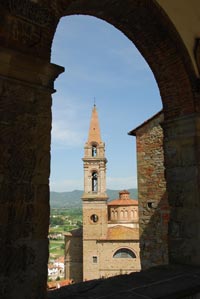 |
|
| N L | Castiglion Fiorentino |
|
| Castiglion Fiorentino is a small, walled city in eastern Tuscany, in the province of Arezzo, between the cities of Arezzo and Cortona. It overlooks both the Val di Chiana and the Val di Chio. Castiglion Fiorentino was previously believed to be of medieval origin, but recent excavations have found its far-older Etuscan base. The city has been closely associated with Arezzo and Cortona for most of its history (one of the legends is that it was founded by inhabitants originally from Cortona) and was one of the pawns fought over and passed repeatedly among the city-states of Arezzo, Firenze, and Perugia in their many battles (called Castiglion Aretino for some time beginning in the XII century until ca. 1290, then Castiglion Perugino for a period and finally Castiglion Fiorentino since ca. 1384). Castiglion Fiorentino's architecture has a predominantly medieval character and includes a wall around the original city center. The first of the existing city walls, including Porta Fiorentina, the main entrance to the town's historical center, was erected in the 13th century, then enlarged in the 14th under the Perugians to connect the castle to the outside walls. Of particular note are Sant'Angelo (XII century - now the Pinacoteca) as well as San Francesco and the Palazzo Pretorio (both XIII century), the medieval Torre del Cassero at the top of the town, and numerous Renaissance structures - e.g. the Loggia by Vasari at the Piazza del Municipio, Chiesa del Gesu, and Chiesa della Consolazione. Built on the site of an Etruscan temple, the church of Sant'Angelo was built in Romanesque style between 1229 and 1239. The church has served as a hospital, wine cellar and workshop before being renovated and used as an official museum and art gallery (the Pinacoteca, or Municipal Art Gallery). It has a fine collection of works such as the French-designed Holy Cross (13C) and the bust of Saint Ursula (early 14C). Paintings include a Cross (early 13C), St. Francis by School of Margarito d'Arezzo (13C), a fragment of a Majesty by Taddeo Gaddi (c.1328), San Michele Arcangelo (c.1480) and the Stigmata of St. Francis (1486), works by Bartolomeo della Gatta. The town's fortress, the Cassero, was completed in 1367. In the 15th century, the nuns of S. Girolamo used the fortress as a convent, and by the 19th century much of the fortress had been destroyed. Re-built with the Casseretto during the Perugians domination of the 14th century, the Cassero Tower, with its bell-gable defines an unmistakable skyline of the town. Through a wooden staircase, recently restored, you can reach the top (up to 35 m) and have a suggestive view of the old town and of the valleys of Val di Chiana and Val di Chio. Museum of the Pieve of S. Giuliano | The parochial museum is situated in what remains of the old Pieve of San Giuliano, nearby the new Collegiate church. Along with 15th-17th-century paintings and panels, we can admire a fresco by Luca Signorelli portraying the Mourning of Christ, and a Baptism of Christ of the della robbian school. The church of S. Francesco, with the beautiful romanesque-gothic sandstone façade, has a semplicity that is typical of the architecture of Mendicant Orders: a single nave with wooden supports, three apses with square plant and transept vaults. Note works of art include: Madonna with Child and Saints (1548) by Vasari; the Crucifixion by Poppi; the Vocation of San Matteo by Salvi Catellucci. In 1513 Vasari constructed a nine arch loggia (Logge del Vasari) in Piazza del Comune, overlooking the valley. The Castle of Montecchio Vespone is a walled, castle with turrets and battlements, which occupies the top of a hill (Montecchio), overlooking the Val di Chiana. Today the Castle of Montecchio Vesponi is the last surviving medieval bastion of its type and is an essential element in the history of the region. Famous visitors to the Castle have included the late Queen Elizabeth, The Queen Mother (of England) who came to learn more about the castle and the area and owned in 1384 by another Englishman, Sir John Hawkwood (known in Italian as Giovanni Acuto). Hawkwood appears in the world famous fresco by Paolo Uccello in the Cathedral of Santa Maria del Fiore, The Duomo of Florence. Montecchio Vesponi is located 4 km south of Castiglion Fiorentino, on the road SS71 to Cortona. Comune Castiglion Fiorentino | it | eng Castello di Montecchio Vesponi |
The Castle of Montecchio Vespone is a walled, castle with turrets and battlements, which occupies the top of a hill (Montecchio), overlooking the Val di Chiana, named and drawn on a well-documented survey map by Leonardo da Vinci in 1503. Today the Castle of Montecchio Vesponi is the last surviving medieval bastion of its type and is an essential element in the history of the region. [1]
|
 |
Castello di Montecchio Vesponi
|
| Montecchio Vesponi is located 4 km south of Castiglion Fiorentino, on a hill at the bottom of Chio valley. In 1344, the Florentine Republic conceded the castle to the captain of good fortune, John Hawkwood (Giovanni Acuto) as compensation for services rendered. . History The first dwellings in Montecchio hill dates back to etrush-roman era, a pagan sactuary might have been built there. Around 9th century the castle was built, part of the fee of Marchiones family and related to Farneta abbey. Other related feudals where the Orselli and Panzoni of Cortona or the Da Vitiano. At the beginning of 13th century became allied of the municipality of Arezzo with the castles of Mammi and Monticello. Around 1234 it was bought by the municipality of Arezzo which settled there more people, made it a municipality under its influence and a stronghold against Castiglion Fiorentino and Cortona. |
|
Walking in Tuscany | Castiglion Fiorentino |
||
| The area of Castiglion Fiorentino is crossed by marked routes of CAI. (Italian Alpine Club). The routes are indicated by signs with white and red stripes, the official colours of the Italian Alpine Club, placed on trees or rocks. There are also direction indicators at crossroads. Also, Luca Serafini recently published a guidebook for mountain biking & trekking titled Intorno a Castiglion Fiorentino, itinerari per mountain bike e trekking. |
||
| Nature walks and cycle paths | Comune di Castiglion Fiorentino | Download pdf |
||
Paths in Val di Chio |
||
| The valley is crossed by several circular paths, pointed out by notice boards and directions. There are three kinds of itineraries: the path of the mills, the path of the villages with their churches and the path of castles. The path of the mills is on a level ground and goes along the river Vingone; the path of the villages winds among settlements on the hillsides at an altitude of 300 m., while the path of the castles goes along the hillstop that enclose the valley. | ||
| The route of «old mills» goes along the ancient stream named Cilone, now flowed into the Vingone after the reclamation works of the past centuries. The route was planned for the enjoyment and relaxing of no agelimit people. The area presents different sorts of environment such as age-old oaks or rows of maples that define the street, as well as a fine view. Along the way we find toponymes that state the old function of this places, such as Mulin Nuovo, Mulino Bianco, Mulino dello Zoppo, etc: the idea of calling it «course of old mills» arises from here. | ||
| Route n.. 50 | Km 17,5 |
||
| Monte Castiglion Maggio - La Foce - La Montanina - Passo Belvedere - Spinabbio |
||
| Route n.. 555 | Km 5 |
||
| Piazzale Garibaldi - Monte Castiglion Maggio |
||
| Route n.. 557 | Km 5 |
||
| Spinabbio - Pergognano |
||
| Route n.. 559 | Km 12 |
||
| Spinabbio - Parco Comunanze - Castello Montecchio |
||
|
|
||
Brolio, Castroncello, Cozzano, La Badia, La Nave, Mammi, Manciano La Misericordia, Montecchio Vesponi, Noceta, Orzale, Pergognano, Petreto, Pieve di Chio, Pievuccia, Ranchetto, Ristonchia, Santa Cristina, Santa Lucia, Santa Margherita and Senaia are frazioni of Castiglion Fiorentino. |
||


